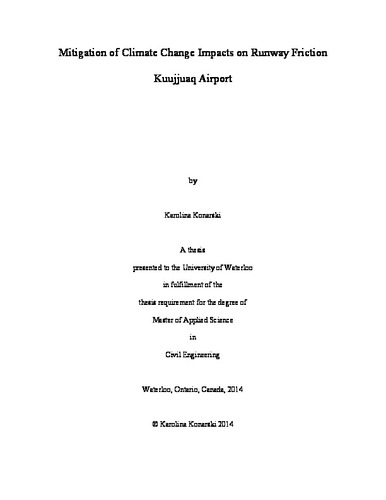| dc.description.abstract | In response to global climate change, Transport Canada has initiated a Climate Change Adaptation Study in order to provide an opportunity to improve knowledge of the impacts of climate change on transportation infrastructure in Northern Canada.
In particular, this research aims to identify ways to mitigate the impacts of climate change on pavement surface friction characteristics at a project specific location: Runway 07-25 of Kuujjuaq Airport in Nunavik, Québec. This site was chosen because it is a complex site with highly variable soil conditions. Runway 07-25 is one of the busier runways in Nunavik and its traffic includes jet airplanes. The runway is also exposed to extensive winter maintenance activities. In addition, Runway 07-25 is considered a short runway and has a crossfall instead of crown for surface drainage. Increasing ambient temperatures have already led to a deeper active layer over permafrost, which affects overall runway performance. Climate change is especially evident in the winter months with large temperature fluctuations resulting in increased freeze thaw cycles. The site is, therefore, a good location to study solutions to climate change impacts, which are expected to affect other Canadian airports in the future.
Kuujjuaq Runway 07-25 is of paramount importance to the community of Kuujjuaq, other communities in Nunavik, and communities north of Nunavik. It serves as a regional hub between the south, Nunavik’s communities and Iqaluit to the north, and provides an essential link for emergency evacuations, personal and business travel, as well as the transportation of basic food items.
Globally, amongst the groups, the most affected by the impacts of climate change are the Inuit communities in Nunavik. Scientists and residents of these communities are witnessing growing evidence of the impacts of accelerated warming in this region, which is expected to continue into the future.
In this research, runway texture and friction are assessed on Runway 07-25, as increased winter maintenance activities resulting from climate change are thought to be reducing surface friction. Existing friction and texture measurement data from previous years, current laboratory testing results on samples of the existing asphalt concrete mix as well as current surface texture and friction measurement data from the runway have been analysed to study trends and characterize the runway in terms of its frictional resistance. Friction improving technologies/products are discussed for maintenance and future rehabilitation options. | en |

